Waka Kotahi’s Innovating Streets pilot has seen dozens of tactical projects appear around the country, and the initial programme is now complete. Some projects will stay in place and evolve along a “pathway to permanence”, while others have reached their conclusion for now.
Collectively, the programme has yielded heaps of data, experience, and insight into processes that should help councils and communities install and adapt more people-friendly spaces, at scale and at pace. It’s also been an illuminating look at what even small-scale projects can make possible in the way of access and connection.
This double-header guest post looks at the recently concluded Hamilton Kirikiriroa Innovating Streets projects from the angles of disability access and urban creativity. Our thanks to authors Maurice Flynn and Dr Jeremy Mayall for permission to share these pieces, which first appeared on the website of Creative Waikato (a not-for-profit organisation existing to help, support, empower and grow the creative sector in the Waikato).
It’s about recognising human diversity and designing for everyone’s needs
by Maurice Flynn, Access Coordinator at CCS Disability Action Waikato
(originally published 24 June 2021)
As part of Hamilton City Council’s Innovating Streets project group from the get-go, I believe the Innovating Streets project has been a great opportunity for our city. We have been able to trial what prioritising people-friendly environments can look like, and what positive impact this can have within our community.
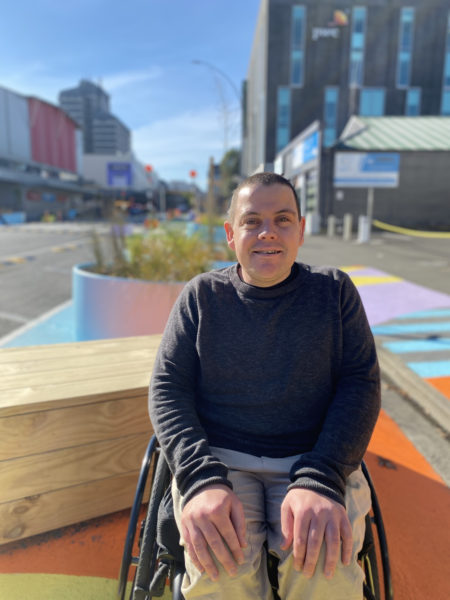
Innovating Streets – the development of Rostrevor and Ward St – is a trial funded mostly by Waka Kotahi – NZ Transport Agency, to support streets to be safer and easier to move around. This project is cheaply trying out a future possibility for our CBD, so we can all see the potential, and tweak as necessary – so we don’t have another costly street that doesn’t work for everyone. There are many examples of poorly designed infrastructure around our city where diverse communities have not had a voice, and in return we get environments that don’t suit people’s access needs, cost time and money to fix, and literally exclude people, with a real potential of injury or death.
The disabled community was a part of this project from day one. We collaborated with our biking community, students from surrounding schools, local businesses and others representing many other communities within our city. Our voices were all heard and listened to. Ward and Rostrevor Streets are currently more people prioritised which means it is easier for everyone – in particular our disabled community – to get around. More importantly, it’s about universal design. Someone with additional mobility requirements, such as a wheelchair user, experiences the same hazards when using a poorly designed street as a parent with small children or a pushchair – it’s about recognising human diversity and designing for everyone’s needs.
When the disabled community is not thought about in the design, we are inconvenienced by environments that do not include us. We have to take longer routes to where we need to go, risking our own safety because of poor design of our roads and crossings.
I do agree the design isn’t perfect, it hasn’t solved the difficulty of crossing Tristram St. Even imperfect, Ward Street under the trial design is a hell of a lot better for people than what it was before. The process on this project was a lot better than previous for two reasons: it was inclusive, and we were able to trial things. Small things have been changed over time of the trial, for example, the mobility parking spaces on Ward St were relocated after feedback was given. It’s important to give feedback, because our council does listen.
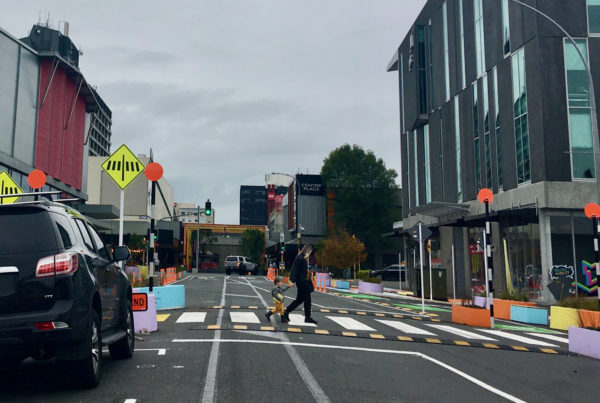
People need to be real about what they are complaining about. There’s by far the most noise from people who dislike the trial because either they now have to manoeuvre their car and pay more attention to what and who is around them, or they may have to walk 1-2 minutes from a nearby carpark. The inconvenience of this is not comparable to the genuinely life-affecting barriers that disabled people face every day. If you are angry about now having to walk from one of the 2100 carparks within 5 minutes’ walk of Ward St, you may need to re-look at your priorities. Threatening small businesses with taking your custom elsewhere because you now have to walk for a couple of minutes doesn’t really mean you were ever a ‘loyal’ customer.
Ward Street is now a safe place to walk and cross, and it’s now possible to bike and scoot safely off the footpath. Te Ruru Light Festival Pop-Up that was held recently on the developed Rostrevor Street was a perfect example of what that space could be used for going forward.
The negative feedback has made it clear to me that a large majority of our community does not like change, however change is what our disabled community rely on to have equal opportunity of participation in the communities that we belong to. I think it is about time we do things differently and reprioritise how we do design within our diverse city.
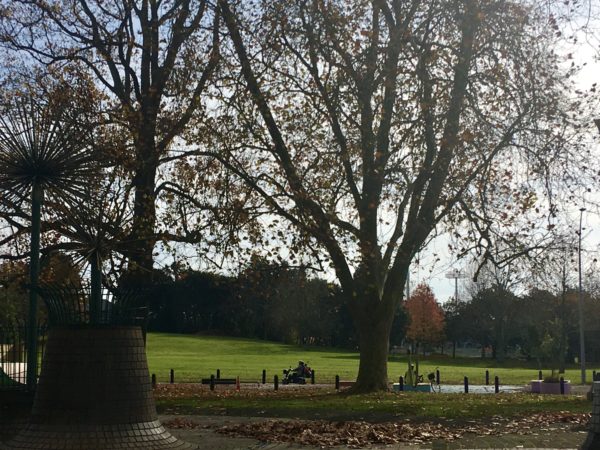
Humans Are Creative Beings
by Dr Jeremy Mayall, CEO of Creative Waikato
Humans are creative beings. This is how we have invented, adapted, innovated and imagined our way from the beginning of human life to now.
Because of this, our capacity for change is immense. Sometimes that change can be difficult, but we have the ability to make sense of it and to re-imagine the way we can collectively move forward into a transformational tomorrow.
As we develop, we learn from each other, we create the spaces where we live, work, and play informed by our current needs, the technologies we use, and the way we move from place to place. But as we continue to grow, we need to find opportunities to take the time to imagine what the world will be like in 10, 20, or 50 years. This is important work because it will allow us to be good ancestors and make sure we set some solid foundations for change if we want to be a vibrant, liveable city in the future.
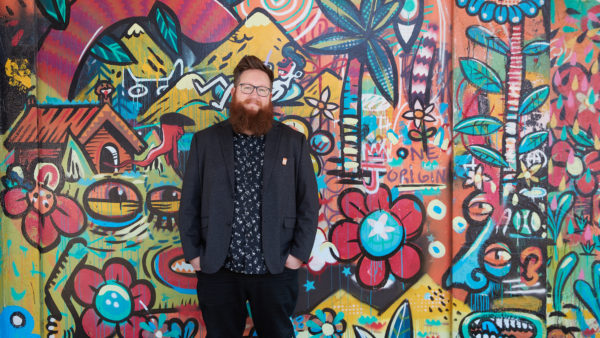
The quality of the environment in our urban areas is of vital importance to this vision. This quality is one of the main factors that determine whether a city is a healthy place to live, whether we enjoy living there, and whether we want our children to grow up there. Some of the key issues that have a negative effect on this is road traffic. In a city area this focus on cars can result in poor air quality, unacceptable levels of constant noise (which is an ongoing health risk for people and animals) and a weakened sense of neighbourhood and local community.
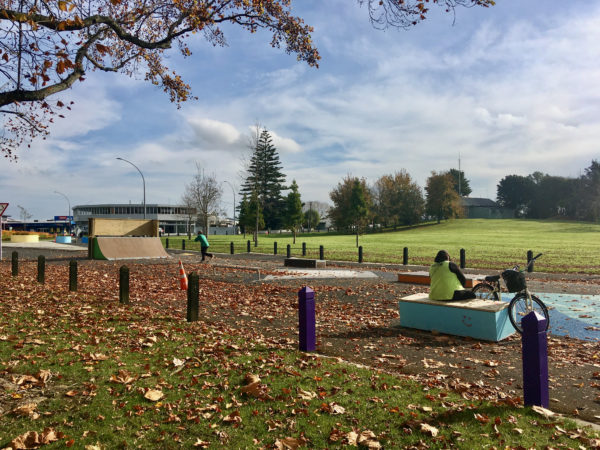
Innovating Streets is an initiative from Waka Kotahi (NZ Transport Authority) that is looking to utilise tactical urbanism as a way to explore the concept of people-focussed streets, (which has been a growing trend internationally) in the cities and communities of Aotearoa. This fund was for projects that used “tactical urbanism techniques such as pilots, pop-ups and interim treatments that make it safer and/or easier for people to move around or access community spaces. Projects could be anything from piloting a new walking or cycling facility to pop-up community-led street events, to trialling a low-traffic neighbourhood or reallocating more street space for people.”
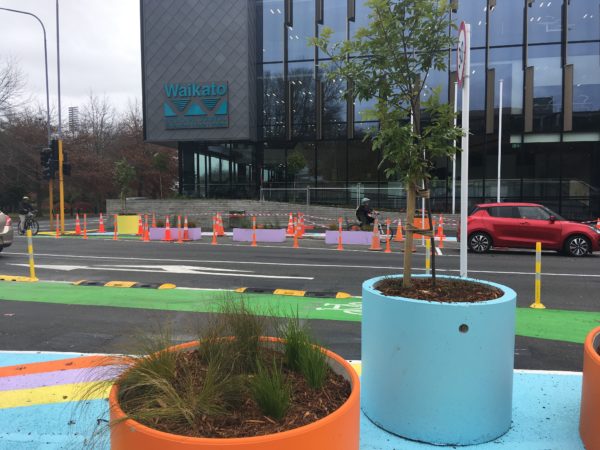
Constrained urban spaces need to accommodate all people and all different sorts of mobility: motorised and non-motorised, individual and collective, fast and slow. Our urban centres need to be reprioritised in favour of transportation modes such as walking, cycling, and public transport, and adapt in a way that encourages more people to be active in those spaces, and to ensure that people actually feel safe in being in those new human-centric (rather that car-centric) spaces. These re-purposed spaces should be highlighting accessibility and safety. These changes can have a hugely positive impact on the economic scale for local businesses as well.
The other exciting thing to mention here is that projects like these enable the addition of creativity and activation to our city spaces. Humans are storytellers. We share through story. We understand through story. We inspire and make change through story. Urban spaces have the potential to be the canvas for those stories – through painting and murals, to sculpture and light, to music and dance and words and more. Our cities are a space for us to share local stories and to inspire conversations, and reflections. Also, by creating beautiful, vibrant, colourful spaces, we can allow space for moments of awe – which is vital for our mental health and wellbeing.
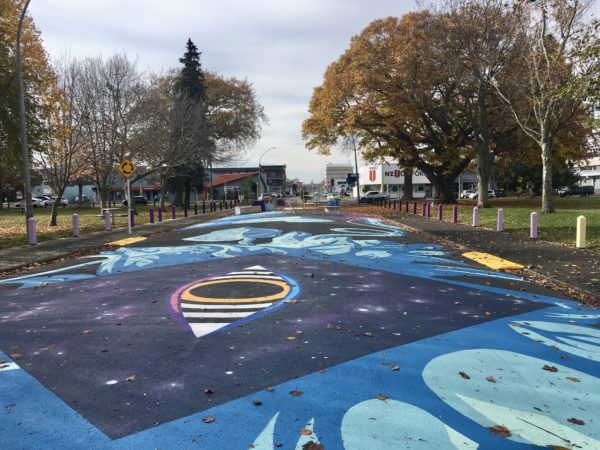
There are many different things to explore when we take the time to create our cities for people. We need to consider option, access, equity, safety, and activity. But when it all comes down to it, aren’t the people who live in our city and the varied human things they do in it, the reason these places exist at all? When we focus our spaces on cars, we are constraining people from moving through space in a non-orderly fashion. When we prioritise a car, or the ability to park right outside a destination, over the interesting, creative, unpredictable, joyful aliveness that human beings will inevitably bring to all public spaces they feel connected to, we’re effectively stripping our streets of their richness.
Editorial footnote: Hamilton’s streetscape makeovers have come to a scheduled end (after one last weekend of family fun and art in carparks!). Traffic once again runs along Rostrevor St through the park, over the eye-catching mural. Meanwhile, Ward St looks set to hang onto a new pedestrian crossing. Copious data, observations and public feedback from both pilot projects will feed into discussions and planning for what comes next for each location. As Creative Waikato says, that’s the idea:
“[It’s] an open invitation to embrace a kind of change that benefits, not just the arts, but the entire community, allowing us to see into a future that’s hopeful, considerate, collaborative, and filled with opportunity.”





 Processing...
Processing...
According to the Waikato Times abandoning the innovative streets trial is a “return to a sense of normality”. There are various other similar gems in their story about the trial.
https://i.stuff.co.nz/waikato-times/waikato-top-stories/125729945/permanent-paint-used-for-hamiltons-innovating-streets-trial
Its a real shame that people are so selfish and anti change. I always feel the loud voices of a few seem to have way too much weighting on changes that often affect everyone.
And the laziness really annoys me too, the amount of people who honestly think a 2 minute walk is too much. Its actually a real worry that as a nation we have become this lazy and car obsessed, forget Covid, this is going to kill many more people.
Totally, it’s really hard not to despair when people get so worked up over some small street changes to actually try and improve things for people (well at least everyone not driving a vehicle).
I often wonder who these people are who go to meetings to complain, write articles, post on social media. Are they just ‘normal’ people, friends of friends, relatives, etc – or is there a whole part of society that is hell bent on opposing anything to do with change. If we can’t agree on some changes like this how will we ever deal with massive, important issues like climate change, etc.
It’s not just going to, it is killing more people. People are dying from heart disease and obesity due to obesity and inactivity. Just this week Treasury have said that health costs and superannuation will sink our economy.
https://www.msn.com/en-nz/news/national/ardern-stays-firm-on-superannuation-age-after-treasury-flags-rising-cost-pressures/ar-AALOsPp?ocid=msedgntp
There is a sliver lining though. With the government’s failure to address climate change, due to coastal inundation, there will be an increasing amount of sand in which they can bury their heads.
It is so good to see an inclusive approach to these “trials”, but to improve them we may need to start including the car-bound anti-changists. To able to provide for everybody must surely be the aim, and removing traffic is the best medicine.
Where I live in Glen Eden, we now have many raised table crossings, and more to come, and it really feels a bit friendlier. In the end we are all pedestrians so let us design our neighbourhoods to suit us!
Innovating Streets used art works to Trojan Horse traffic management changes without consultation or safety audits. Did it succeed? I guess you would need to compare crash rates and count up the number of pissed off people to answer that question.
Miffy, why are you lying so much recently. The article that you are currently commenting on describes the consultation that was completed.
Normally consultation involves engaging with people who might be opposed as well as those who might support a project. Innovating Streets was based on tactical urbanism which is relies on making the change before people can object to it. The whole basis of Innovating Streets was to shortcut the normal process. Many of the Innovating Streets projects used art as a cover for installing concrete tubs, boxes, closures and restrictions. In a number of projects the people bit back. It is almost as if we started to consult with people for a reason.
Miffy the point of innovating streets consultation is to consult about something people can see and experience rather than just imagine from plans. People might find it isn’t the end of the world if they get a chance to get used to it before giving feedback.
Yes or they might start protesting in the streets. If you take that approach then you really have to accept the feedback in whatever form it arrives.
You obviously have never done public consultation then. The issue with standard consultation is that you ONLY engage with those that oppose it.
Neither sentence is true.
Hi Miffy, one of the people who was at the community workshops. There were about 30 people voluntarily from various communities. Four hours workshops with four in total.
Some of the community representatives included business owners, large and small, disability, arts, urban planners, architects, developers, events, low vision, high school representatives, staff and students, sports groups, cyclists and general users. .
Each group and individuals had opportunity to have an opinion and voice. Each and every single community group representatives had to make a compromises in order to work in with each other.
Are you lying about the engagement protest or are you genuinely that misinformed that you believe what you wrote?
I don’t know anything about what they did in Hamilton but as you should have seen from the very first line WK funded dozens of these projects. If you want to know how satisfied people were with some projects go and ask the thousands that marched against the one in Henderson. I have ignored your allegations of lying up to now but there is a point where I won’t. Think before you make that allegation again.
Yes, Hamilton, Kirikiriroa, is the one I was referring to for community workshops. Waka Kotahi has the list of requirements Councils have to meet on their website including detailed videos.
That sounds like a better approach. The people I talked to at one town centre told me Panuku showed them some amazing pictures of the art work and told them about the money they would be spending to improve the area, then subsequently AT sent along a plan that they felt made everything worse than it was already. It created traffic chaos which lasted until the works were removed.
“Think before you make that allegation again”
I think that no one with your experience can possibly be as misinformed as you would have to be to genuinely believe the things that you are saying. Therefore, I think that the only reasonable conclusion one can draw is that you are lying, either to incite a response or, more likely, to derail projects that you disagree. I think it’s great that these projects are gaining so much momentum that opponents feel that repeatedly and egregiously lying is the only way to stop them.
By the way, you are incorrect about the only project you have specifically called out. https://akhaveyoursay.aucklandcouncil.govt.nz/henderson-streets-for-people/widgets/334192/faqs#question76239
The organisers of the protest in Henderson were claiming 200-250 turned up – certainly not thousands.
True! Because streets are about more than traffic.
Crash rates should have been easy to record, pissed off people can be relied on to be self-reporting.
I wonder how they measured appreciation for quiet streets, conversation and ease of pedestrian access?
Spoken like a true bullshitting traffic engineer Miffy. Peddling personal views as if they are science. As if you would expect crash rates to be measurably down in the space of a couple of weeks. What a clown.
+1, comments like this from Miffy make me embarrassed to be a part of the same profession.
Don’t flatter yourself. None of my peers would go on line and accuse another of being a liar.
Your peers may not be willing to call out your dishonesty, but other people in the profession sure are.
The biggest gripe about all of the innovating Street projects was the lack of engagement prior to trials starting. In this totally connected world, councils have to use the very tool,(social media),that is used to beat them up. Nonetheless, no amount of early engagement, prepares anybody for having total access to their habitual driving pattern interrupted. The councils also appeared to be slow to get roading layout changes accepted by the gps mapping providers, therefore directing vehicles into a never ending dead end, easy to see how opposition quickly escalated. The projects need a high profile champion (Sarah Ulmer stood up in Cambridge), the politicians have kept their distance,knowing that it is politically impalatable to back roading reallocation.
On a more positive side though,(or is it), Climate Change refuses to go away, and will “drive” change eventually, l look forward to the day ,when a high profile elected official is prepared to put his /her position on the line, and back some game changing projects.
The latest person to announce Auckland mayoralty campaign has me wondering though, and ChCh mayor has paid the price of backing completion of cycling network.
Innovating Streerts projects had *more* engagement before implementation, not less.
They are proof that a certain amount of people will reflexively oppose any change at all and will only ever engage to derail projects.
Some of the projects had plenty of consultation about the artwork and barely any about the traffic management changes. It was a trojan horse exercise. They seemed to think people would like the artwork so much they wouldn’t notice the rest.
Miffy, could you give a few examples of projects that “had plenty of consultation about the artwork and barely any about the traffic management changes”?
That doesn’t track with what I’ve seen. But maybe you’re closer to the action?
“ChCh mayor has paid the price of backing completion of cycling network” – um, what? The current Chch mayor has just decided she won’t stand again at the next elections in over a year’s time after three terms – not sure how you manage to link that to the cycle network; I’d say it has more to do with her partner recently dying. Meanwhile, all the pro-cycleway Councillors in Chch have continued to be voted in each election lately…
There has been very vocal opposition by small businesses, such as Hamilton Tyre and Battery. Obviously small businesses based on motoring are going to oppose changes that reduce motoring and parking.
https://www.stuff.co.nz/waikato-times/news/125226320/angst-admiration-as-hamiltons-innovating-streets-trial-moves-to-next-phase
Students at a local high school and Polytech students have found walking and cycling safer and more pleasant, and liked the street art. However, these groups are not currently very active in local government politics. The Hamilton deputy mayor is taking an unabashedly pro-roads position, and managed to mobilise support in favour of free parking, at the expense of green space, at the Hamilton gardens.
I suspect there is a need to change people’s preferences in favour of exercise and active commuting. Rather than complaining they need to walk for 2 minutes they need to be persuaded that for health reasons walking is in their own personal interests. This is a more effective argument than climate change, because while changes by a few individuals won’t reduce greenhouse emissions they will make those individuals fitter and healthier. Obviously this won’t appease firms selling motoring products, for whom the loss of roadside parking is a disaster in a city where people are used to being able to park everywhere, but it might result in other people’s position on reallocating road space changing. Giving students a grant to buy a bike, in order to improve their physical fitness, would also increase the size of the constituency advocating for cycle ways and active commuting in Hamilton.
I drove through a few weekends ago, coming back to Auckland.
It was foggy, 11pm, cold so there was heaps of wood smoke, not a breath of wind.
With all the road construction going on it felt like a fever dream, an all in on roads, dream for a future that shouldn’t exist.
As far as I see it, with the current roads projects, Hamilton doesn’t have the advantage that Auckland does, congestion. Auckland has nowhere to go with road construction, and so essentially has to include transit / active modes in its designs to increase capacity, and people use it because of the massive congestion. But it seems to me that Hamilton doesn’t have that, and the bed is made. Lost cause. Massive unabashed taxes on fuel and associated decrease in ability to move around seem to be the only solution for the Tron to reduce its emissions to the level required. The city of the wrong future.
But what would I know, I only ever pass through.
The area around the university in Knighton is now quite high-density, with lots of 2 and 3 storey apartment blocks. Most of the houses in Knighton have now been replaced by apartment blocks. The university also charges for car parking. This would seem a good place for more living streets initiatives, and making the roads more suitable for pedestrians.
More inner city housing is also being built, and these residents will want to improve the urban environment.
Parking is $2 a day or $60 per trimester (75c/day). Good on them – still free parking at Massey Albany – but maybe it is too cheap to have any effect.
And yet Hamilton is building more cycleways than Auckland despite having 1/10th as many residents and far less congestion. The city also built a major PT Hub and the bus network is progressively transitioning to a frequent core service model, with infrastructure actually funded in the RLTP. Hamilton is doing more off of a low base than Auckland are doing with huge public demand for non-car travel options.
I’m a bit conflicted with these projects. Other than some disruption to cars, these project generally all seem to have great safety/amenity improvements to people walking around which is great.
I felt they just gave up too soon. Should have been left for a year and let people provide feedback over the course of a year.
I was quite disappointed with the vandalism of the Onehunga project. It was way better for children walking around and for cyclists to filter through. And delays to drivers were not really that high. Most of the people complaining are people that don’t live there and just rat-run through the residential streets.
I think many people in Onehunga still had big lawns, and didn’t perceive there was a need for more parks. In a higher density area there might be more demand for shared space.
The Onehunga Kotahi facebook page is a bit of an echo chamber, but nevertheless there is demand in the posts for better public transport, better road markings, speed bumps, speed cameras, and for consultation. It would be desirable to ask the locals how they would make the streets safer, and make it possible for children to walk and cycle to school.
Is the walking and cycling to school thing still realistic for the majority of children? I’m thinking that in Auckland, where two parents need full-time jobs to pay the mortgage, parents who have to put their children in before- and after-school programs to facilitate their jobs may not see the walking and cycling option as feasible any more, as children would be travelling earlier and later than they would if they were only going to school.
Perhaps this is not actually a big issue, but has there been research specifically into children’s travel?
Perhaps parents need to be encouraged to see that there are benefits in active commuting too. I’m not entirely sure how to point out to them that being fit and unfit is unhealthy.
Nice post, thanks.
“Humans are storytellers. We share through story. We understand through story. We inspire and make change through story. Urban spaces have the potential to be the canvas for those stories”
I know I’ve heard words like these before but it hadn’t really sunk in that we need stories in the streets and public places. I hadn’t really thought about it. All I’d thought about was that I wanted the Innovating Streets projects to improve our places, and bring the transport changes we need.
Thanks for helping me join up the dots. I like this:
“But as we continue to grow, we need to find opportunities to take the time to imagine what the world will be like in 10, 20, or 50 years. This is important work because it will allow us to be good ancestors and make sure we set some solid foundations for change if we want to be a vibrant, liveable city in the future.”
Perhaps parents need to be encouraged to see that there are benefits in active commuting too. I’m not entirely sure how to point out to them that being fat and unfit is unhealthy.
The neat thing about innovating Streets for People projects (besides getting safer streets that are nicer to be on) is the process. Tactical urbanism is different from normal processes in a couple of important ways – and when done well it’s *more* participatory than normal process. When done badly you get the worst of crap council consultation processes: technocracy plus exclusivity of public participation. Have a read of this https://parcitypatory.org/2020/07/31/tactical-urbanism/
And this is a favourite diagram summing it up https://www.hamilton.govt.nz/our-city/city-development/transport/PublishingImages/Process%20diagram%208%20June-01.jpg
As urban nerds who are generally into better cities, every regular reader and commenter on Greater Auckland needs to be au fait with tactical urbanism and know how to spot BS process from fifty paces.
There’s been plenty of BS in this first Innovating Streets funding round mostly by councils attracted by the 90% funding. It tarnishes the name of tactical urbanism, and does a disservice to the projects where councils and communities have rolled their sleeves up and properly embraced tactical urbanism.
Waka Kotahi / NZTA have provided good support, but nothing like the air cover that projects need (Exhibit A: Onehunga) which I suspect they’ll change for future iterations of the programme.